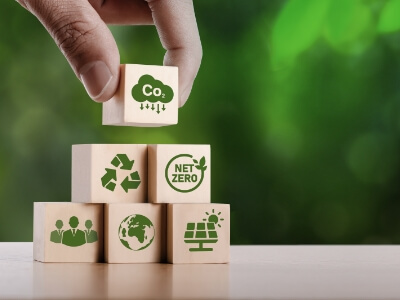Realizing a Low-Carbon Society
As our business does not involve operating manufacturing facilities, our CO2 emissions are relatively low compared to manufacturing industries. Nevertheless, we take our responsibility as a corporate citizen seriously and are committed to further reducing CO2 emissions.
Specifically, our initiatives include turning off office lights when not in use, promoting energy-saving dress codes such as Cool Biz and Warm Biz, and reducing electricity usage.
Going forward, we will continue to work to lower our CO2 emissions and contribute to the prevention of global warming.
Eco-Friendly Sales Vehicles

Currently, approximately 90% of our sales vehicles are energy-efficient. When replacing vehicles, we adhere to a standard practice of selecting energy-efficient options, aiming to achieve 100% adoption in the future.
Proactively Turning Off Office Lights

Division in charge leads efforts to reduce electricity consumption while maintaining a comfortable work environment. To achieve this, the following initiatives have been implemented:
- Setting designated temperatures for each area and managing air conditioning power usage.
- Broadcasting internal announcements to ensure air conditioning is turned off when not in use.
- Promoting energy conservation activities in alignment with our Energy Conservation Guidelines in line with national regulations.
One of the TK Group’s goals within the ISO 14001 environmental management system is to conduct regular performance monitoring, compare results with the previous fiscal year, and implement targeted measures in response to the findings.
Promoting Casual Business Attire

Since 2022, we have promoted a casual business dress code as part of our “casual day” pilot program. Building on this, in April 2023, we adopted a daily casual business dress code. This initiative is part of our efforts to combat global warming through Cool Biz and Warm Biz programs, while also supporting work style reforms, respecting employees’ autonomy, and encouraging personal growth and self-expression.
Formation of a Circular Economy
Paperless Initiatives

As one of the goals of the TK Group’s environmental management system, we promote paperless initiatives aimed at reducing paper usage. These include minimizing printed materials and copies, double-sided printing, printing multiple pages per sheet, reducing printing errors, receiving faxes electronically, and increasing the use of monitors. We also regularly track our performance, compare results with the previous fiscal year, and implement targeted measures in response to the findings.
Waste Management and Reduction
Industrial Waste Reduction

As part of the TK Group’s environmental management system, we actively promote the reduction of industrial waste. We regularly track our performance, compare results with the previous fiscal year, and implement targeted measures in response to the findings.
Proper Separation and Recycling of General Waste

Each department is responsible for ensuring the effective separation of general waste, and the appropriate processing of recyclable materials for reuse, including the collection of old PCs and smartphones by specialized vendors.
Addressing Climate Change
As a technology trading company centered on electronics, our company has made it its mission to promptly introduce the world‘s most cutting-edge products and continue to provide new value to the market. In light of the Paris Agreement and the United Nations’ promotion of the Sustainable Development Goals (SDGs), the movement to solve social issues has gained momentum, and interest in ESG investment is growing in the stock market. In response, our company is committed to contributing to the sustainable development of industry and society by addressing social issues through our business practices. While our company’s direct environmental impact on climate change as outlined in the recommendations of the Task Force on Climate-related Financial Disclosures (TCFD), established by the Financial Stability Board, is not expected to be significant, we recognize the importance of addressing climate change and view this as one of our management priorities.
We acknowledge the significance of addressing climate change concerns and of disclosing financial data accordingly. To this end, we will carry out the following initiatives: assess risks and opportunities, such as reducing GHG emissions, reviewing energy consumption, and preparing for natural disasters from a medium- to long-term perspective, with a view to aligning with the recommendations of the TCFD.
Governance
The Takachiho Koheki Group acknowledges the significance of environmental conservation, including climate change, and risk management as core elements of its Basic Sustainability Policy, with the Board of Directors playing a pivotal role in deliberating and overseeing progress. To advance our TCFD initiatives, we have established a Sustainability Promotion Project led by the director responsible for environmental management. Decisions related to TCFD made within this project are submitted to the Board of Directors, where climate-related risks and opportunities are assessed annually. Additionally, the Board reviews progress on related targets and initiatives to ensure effective oversight. This initiative is conducted within the framework of our Sustainability Promotion System.
Strategy
We examined the timing of the impact of opportunities and risks posed by climate change in the three segments of Cloud Services and Support, Systems, and Devices, which are the main businesses of the Takachiho Koheki Group, from the short, medium, and long term perspectives. In the 4℃ scenario, considering physical risks such as extreme weather and natural disasters due to temperature rise, we identified opportunities within our Group. In the 1.5℃ scenario, we identified opportunities within our Group by considering transition risks in implementing climate change measures such as policies, regulations, and requests from related organizations. In addition, we assess the impact of the identified opportunities and risks on our Group’s business activities and finances as high, medium, or low.
Risks and Opportunities Related to Climate Change
The timeframe of impacts is assumed to be: short-term (0-3 years), medium-term (4-10 years), and long-term (11-30 years).
Scenario Analysis
To assess the resilience of business strategies to the risks of climate change, we analyzed climate risks and opportunities based on two scenarios in which the temperature rise in the 21st century is (a) 4℃ (a scenario in which the world continues to emit greenhouse gases at current levels) and (b) less than 1.5℃ (a scenario in which GHG emissions are rapidly reduced). As a result, (a) is expected to be impacted by floods and other disasters caused by extreme weather events due to climate change, and (b) is expected to be impacted by the increased cost of doing business due to the introduction of a carbon price. However, the results of the scenario analysis confirmed that the demand for products and services is expected to exceed the costs in all scenarios, assuming a growing need for security, safety, and comfort in the fields of networks, surveillance camera systems, and homes in which our company operates.
Scenario Analysis Process
We selected members from each business unit and set up working groups with external experts to conduct the scenario analysis. We created scenarios for the physical and transition risks of climate change and identified potential future events and impacts on value chains in each scenario in terms of risks and opportunities. Our company’s current efforts and future prospects have been summarized for each identified impact on the Company.
- Step 1: Develop scenarios based on climate-related scenario analysis
- Step 2: Identify and assess risk factors that could significantly impact the business
- Step 3: Evaluate potential responses to identified risks and opportunities
Selected Climate Scenarios
4℃ and 1.5℃ scenarios based on publicly available information from the International Energy Agency (IEA) and the Intergovernmental Panel on Climate Change (IPCC).
Physical scenario: See IEA Stated Policies Scenario (STEPS) and IPCC RCP 8.5 scenario. Temperature increases by almost 4℃ from the late 19th century to 2100. The physical impacts (physical risk) of climate change, such as disasters, become more pronounced. Because there will be no stricter regulations on climate change, the impact of transition risks will be small.
Transition scenarios: See IEA Net Zero Emissions by 2050 (NZE), IEA Announced Pledges Scenario (APS), and IPCC RCP2.6 Scenario. Temperature rise is limited to 1.5℃ from the late 19th century to 2100. The impacts (transition risks) associated with the transition to a decarbonized society, such as the introduction of a carbon pricing system and GHG emission regulations, have become prominent. The impact of physical risks is relatively small compared to the 4℃ scenario.
Risk Management
The Takachiho Koheki Group has established a Crisis Management Committee, chaired by the President and Representative Director, to manage business and operational risks and events related to quality, environment, business problems, information security, and other issues in each database. Risks are ranked according to severity and frequency of occurrence, and reviewed by the committee on a quarterly basis. Climate change risks are managed in the same manner. Identified risks and opportunities are assessed by the Sustainability Promotion Project as appropriate, and the results of the assessment are presented to the Board of Directors for deliberation and progress management.
Our company has acquired environmental management system certification (JISQ14001:2015/ISO14001:2015), and conducts environmental impact assessment through the environmental management system to identify risks such as environmental impact including GHG emissions. Since the transition risks and physical risks associated with climate change required by the TCFD may significantly change the business environment itself, we will hold discussions on sustainability promotion projects, etc., and consider an approach to selecting, managing, and assessing risks according to the TCFD framework through scenario analysis in addition to the environmental impact assessment through the environmental management system.
Indicators and Targets
As indicators for assessing and managing identified risks and opportunities, our Group measures Scope 1, Scope 2, and Scope 3 GHG emissions from its business activities, and sets medium- to long-term targets. We aim to achieve net zero emissions by fiscal 2050.
Notes:
- Current Scope 1 and Scope 2 are not consolidated. We will measure them on a consolidated basis in the future.
- For Scope 1 and 2, we aim to reduce the combined value of both by 40% in fiscal 2030 compared with fiscal 2021 results.
- For GHG emissions from 2030 for Scope 1 and 2, we will make every effort to reduce GHG emissions. We plan to offset the remaining amount that is difficult to reduce, such as the 66 Scope 2 target for fiscal 2030.
- Scope 3 is currently being calculated. Non-consolidated and consolidated targets will be set when results can be calculated.